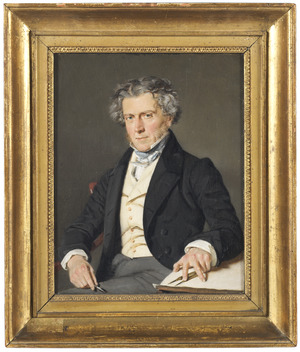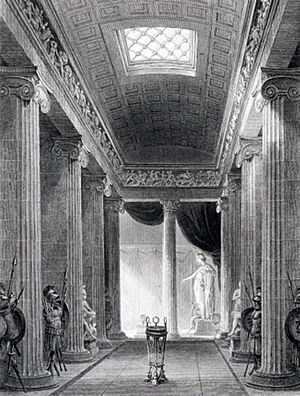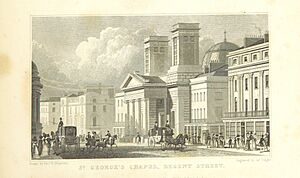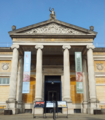Charles Robert Cockerell facts for kids
Quick facts for kids
Charles Robert Cockerell
|
|
|---|---|
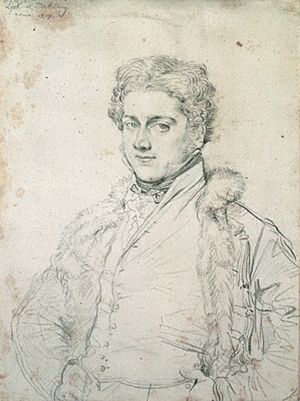
Charles Robert Cockerell (portrait by Ingres, 1817)
|
|
| Born | 27 April 1788 London, England
|
| Died | 17 September 1863 (aged 75) 13 Chester Terrace, Regent's Park, London, England
|
| Occupation | Architect |
| Spouse(s) |
Anna Maria Rennie
(m. 1828) |
| Children | 10, including Frederick |
| Parent(s) | Samuel Pepys Cockerell Anne Whetham |
| Awards | Royal Gold Medal (1848) |
| Buildings | Ashmolean Museum |
Charles Robert Cockerell (born April 27, 1788 – died September 17, 1863) was a famous English architect, archaeologist, and writer. He studied architecture with Robert Smirke. Charles then went on a long trip called the Grand Tour. This trip lasted seven years, mostly in Greece. During this time, he made important archaeological discoveries.
When he came back to London, he started a very successful architecture business. He became a Professor of Architecture at the Royal Academy of Arts from 1839 to 1859. He also wrote many books and articles about old buildings and history. In 1848, he was the first person to receive the Royal Gold Medal for architecture.
Contents
Early Life and Learning
Charles Robert Cockerell was born in London on April 27, 1788. He was one of eleven children. He went to Westminster School from 1802, where he learned about Latin and old Classics.
When he was 16, Charles started training in his father's architecture business. His father, Samuel Pepys Cockerell, was a surveyor for important buildings in London. From 1809 to 1810, Charles helped Robert Smirke rebuild the Covent Garden Theatre. This theatre is now known as the Royal Opera House.
His Grand Tour Adventure
On April 14, 1810, Charles began his Grand Tour. Because of the Napoleonic Wars, many parts of Europe were closed to British travelers. So, he traveled to places like Cadiz, Malta, and Constantinople (now Istanbul). From there, he went to Troy and finally arrived in Athens, Greece, in January 1811.
In Constantinople, he met John Foster, another architect. They traveled together. In April 1811, Charles helped dig up parts of the Temple of Aphaea on the island of Aegina. He found broken sculptures from the temple's roof. He discovered these sculptures were once painted with bright colors!
On August 18, 1811, he and three friends explored Morea. They wanted to find the Temple of Apollo Epicurius at Bassae in Arcadia. Charles found the amazing Bassae Frieze at this temple. These sculptures were later dug up and sold to the British Museum.
His journey continued to places like Sparta, Argos, Mycenae, and Corinth. He returned to Athens, where he met Frederick North. North convinced Charles and Foster to go to Egypt. They traveled through Crete, but North changed his mind.
So, Charles and Foster decided to visit ancient Hellenistic cities in Asia Minor. They visited places like Smyrna, Pergamon, and Ephesus. In July 1812, Charles got a fever in Malta and was sick for three weeks.
By August 1812, they were in Sicily. They spent months studying Greek temples there. They even drew how the Temple of the Olympian Zeus, Agrigento might have looked. Charles spent time in Syracuse, Sicily, drawing for a book about his discoveries.
He returned to Athens but got sick again. After he recovered, he continued his travels. In January 1814, he met Ali Pasha in Ioannina. He went back to Athens and then to Zakynthos to see the sale of the Bassae Frieze.
In December 1814, he went back to the Temple of Aphaea to check his drawings. He also wrote about his discovery of "entasis." This is a slight curve in columns, like those on the Parthenon, that makes them look straight.
Because Napoleon gave up his power in April 1814, Sicily and Rome were open to British travelers again. On January 15, 1815, Charles went to Naples with Jakob Linckh. They visited Pompeii and arrived in Rome on July 28.
In Rome, Charles met many famous artists like Jean Auguste Dominique Ingres and Antonio Canova. He wrote to his father that people were very interested in his drawings. He spent a lot of time getting his drawings ready to be published.
In 1816, Charles moved to Florence. He was honored by the Accademia delle Arti del Disegno. While in Florence, he designed a grand Wellington Palace for the Duke of Wellington. It was meant to be in the Greek Revival architecture style, as big as Blenheim Palace. However, it was never built.
After Florence, Charles visited Pisa, Bologna, and Venice. He stayed three weeks in Venice. From there, he saw buildings by Andrea Palladio. He then visited Mantua, Parma, and Milan. He returned to Rome and then traveled home through Paris in March 1817.
Back in England
Charles returned to London on June 17, 1817. His trip had lasted over seven years, much longer than the planned three years. He started preparing his drawings of Greek ruins for an exhibition at the Royal Academy.
Charles lived and worked at 8 Old Burlington Street, which belonged to his father. He kept his office there until 1830. He was a member of several gentlemen's clubs, including the Athenaeum Club and the Travellers Club. He was even a founder of the Travellers Club in 1819.
In 1819, he became the Surveyor of the Fabric of St Paul's Cathedral. This meant he was in charge of the building's upkeep. One of his jobs was replacing the ball and cross on the dome in 1821.
Charles was part of a group that studied whether the Elgin Marbles and other Greek statues in the British Museum were originally colored. He was elected an Associate of the Royal Academy in 1829. He became a full academician in 1836.
In September 1839, he became Professor of Architecture at the Royal Academy. He won the first Royal Gold Medal for architecture in 1848. He also became president of the Royal Institute of British Architects in 1860.
In 1833, he became the surveyor for the Bank of England. He added to its London building. He also designed branch offices in cities like Manchester, Liverpool, Bristol, and Plymouth.
Charles showed his drawings of ancient Rome and Athens at the Royal Academy. He also created a famous drawing called "Tribute to the Memory of Sir Christopher Wren." These drawings became well-known through printed copies.
As an archaeologist, Charles is remembered for taking the reliefs from the Temple of Apollo at Bassae. These sculptures are now in the British Museum. Copies of these reliefs were put in the library of the Travellers Club.
The Royal Academy of Arts wrote about Charles Cockerell. They said he had an amazing eye for how buildings were put together. For him, old architectural shapes were not just copied. They were a way to show how humans always want to create beauty.
Architectural Projects
Charles Cockerell had some doubts about using Greek Revival architecture in England. In his diary in 1821, he wrote that Greek temples were not meant for houses. He thought they were too serious and that houses needed a lighter style.
His first building (1818–20) was the 'old schools' at Harrow School. It was built in the Tudor architecture style with brick. His next project was the classical Hanover Chapel (1821–25) in Regent Street. This chapel had two towers but was later taken down in 1896.
Buildings from the 1820s
- 1818–20 – Old Schools, Harrow School.
- 1819-36 – Oakly Park, Shropshire, renovation work.
- 1820–26 – Loughcrew House, County Meath, Ireland.
- 1821 – Tower and front of St. Mary's church Banbury.
- 1821 – Library and Chapel, Bowood House, Wiltshire.
- 1821 – Hanover Chapel, Regent Street, London (now gone).
- 1822–27 – The Saint David's Building, University of Wales, Lampeter.
- 1824–28 – Langton House, Dorset (now gone).
- 1824–29 – The National Monument, Edinburgh, with William Henry Playfair, not finished.
- 1827-28 - Newbridge Lodge, Wynnstay, North Wales.
- 1829 – Church of Holy Trinity, Hotwells, Bristol.
Buildings from the 1830s
- 1831 – Westminster, Life and British Fire Office, London (now gone).
- 1835 – The Bank of England, Courtney Street, Plymouth.
- 1836–37 – Cambridge University Library, only one part was built.
- 1837 – London and Westminster Bank, City of London (now gone).
- 1838 – The Chapel, Killerton, in a Neo-Norman style.
- 1838 – London & Westminster Bank, Lothbury, London (with William Tite).
- 1839–45 – The Ashmolean Museum and Taylor Institution, Oxford University.
Buildings from the 1840s
- 1840 – Seckford Hospital, Woodbridge, Suffolk.
- 1841 – Sun Fire Office, London (now gone).
- 1844–47 – The Bank of England, Bristol.
- 1845 – The Bank of England, King Street, Manchester.
- 1845–48 – The Bank of England, Castle Street, Liverpool.
- 1848 – Fitzwilliam Museum, Cambridge University, he designed the inside after the first architect died.
- 1848 – Bank Chambers, Cook Street, Liverpool (now gone).
Buildings from the 1850s
- 1851–54 – St. George's Hall, Liverpool, he designed the inside after the first architect died.
- 1855-57 – Liverpool, London and Globe Building, Liverpool.
Personal Life
On March 23, 1828, Charles proposed to Anna Maria Rennie. She was 25, and he was almost 40. They got married on June 4, 1828. They had ten children. Their son, Frederick Pepys Cockerell, also became an architect. Another son, Robert, became a soldier and died young in the Battle of Alma. Their youngest son, Samuel Pepys, later published his father's travel diaries in 1903.
By 1851, Charles was not in good health. He mostly stopped working on new buildings. He died on September 17, 1863, at the age of 75. He was buried in the crypt of St Paul's Cathedral.
Published Works
Charles Cockerell wrote many books and articles, including:
- Travels in Southern Europe and the Levant, 1810–17 (his travel journal).
- On the Aegina Marbles (about the sculptures he found).
- On the Labyrinth of Crete.
- An Account of Hanover Chapel, in Regent Street.
- The Temple of Jupiter Olympius at Agrigentum.
- The Pediment Sculptures of the Parthenon.
- Iconography of the West Front of Wells Cathedral (about church sculptures).
- The Temples of Jupiter Panhellenius at Aegina and of Apollo Epicurius at Bassae (about the temples he explored).
Images for kids
-
St. Mary's Banbury
-
Scottish National Monument, Edinburgh, with William Henry Playfair, unfinished
-
Library, Bowood House
-
The Chapel, Killerton


